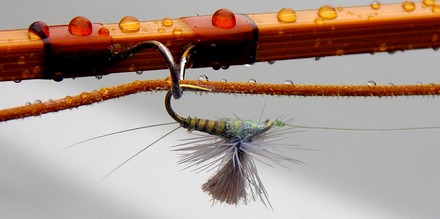Â

When I left for the Fly Fishing Retailer show, fall was merely a threat on the horizon. When I arrived home, I discovered it was here waiting for me.
Wednesday was cold and windy -- the prototype of the gray fall day -- and the heater fired itself up for the first time this year as the outside temperature hit a chilly 38 degrees.
Thursday warmed, and while I got lost in the mountains around Trout Creek with Curtis Knight and Drew Simmons of CalTrout (taking in the McCloud Redband Trout habitat restoration projects), the weather turned beautiful again.
Sure, fall means the short, dark days of winter are coming, but it also means the river will wake up from its summer doldrums. That ain't bad.
The October Caddis EffectSoon, the October Caddis will leave the bottom of the river and -- on some nights -- fill the air with pumpkin-colored bugs the size of small hummingbirds.
Naturally, the big bugs draw big crowds, and in October, the river's often overrun by fly fishers. Clubs flock here en masse, yet it's impressive how rarely the hatch pays off for most fly fishers.
It's common to catch trout on #18 PMD dries while clouds of October Caddis obscure the sky, and the dirty little secret is that the best October Caddis dry fly fishing usually comes much later in the year -- when the caddis adults are dying, the fish are watching for dead drifted specimens, and the river is empty.
Meanwhile, BWO hatches start popping up in some surprising places, and the river's normally as low and clear as it gets. Oddly, the late Fall BWOs are smaller than those that typically hatch in winter (#20 or #22 vs an #18), and I wish it was the opposite so I could ease into the tiny bug fishing a little bit easier.
At this point in the year, the trout in the flatter, more technical water get pretty damned spooky -- many simply stop rising when you false cast anywhere near them -- and your margin for error on the cast dwindles. That's when I turn to Sully's Extraterrestrial Leader --
the 16.5' product of an alien civilization.
Don't try to fish an October Caddis dry with the thing, but
The GearGear choices in the fall are never easy; one minute you're nymphing a big, heavy October Caddis pupae, and the next you're fishing 7x tippet with #20 BWOs on flat water. In between, you could end up slapping a big, bushy October Caddis dry in pocket water seams.
In other words, when you walk away from the truck at the start of the day, you better not be holding a one-trick pony fly rod.
My old solution was a reasonably tapered, very smooth bamboo 6wt. It had the line mass to boss a bigger fly, but the flex to protect extremely light tippets.
Sadly, three winters ago, an icy boulder shifted underneath me and tossed me hard onto the ground (with my beloved 8' 6wt quad beneath me), so that's not the option it used to be. (Actually, it's not an option at all. It's kindling.
Since then, I've run through a series of 8.5' and 8' 5wt bamboo and fiberglass rods looking for the
Universal Fall Fishing Replacement Rod, but now I realize that I'm pretty much going to fish whatever strikes me that day anyway, so why agonize?
I have committed to a pair of rods for technical BWO fishing: Raine's 8'3" 4wt hollowbuilt cane rod and a Diamondglass 8.5' 4wt glass rod. Both rods are so sweet and effective that I'm pretty sure I don't have to show up to catch fish.
(Sure, love is blind -- remember when you thought your high school girlfriend's awful laugh was cute??)
Whatever your choice, it helps to if you can change leaders relatively quickly, and while I don't much like braided line loops, it's one time of the year they might be worth the hassle.
The FliesFlies, of course, are wildly personal things, and my suggestions are limited to the broadest strokes. You need some kind of big October Caddis pupae, including a heavily weighted version. Something as simple as an amber-ish Hare's Ear Soft hackle in size 6 or 8 will do, but certainly, more sophisticated versions exist.
Stimulators are the workhorse October Caddis dries, but I prefer something that sits lower in the water, and hooks more of the fish that eat it.
I eventually came up with a fly that included a bouyant elk hair body lashed to the hook, overdubbed with a pumpkin/amber dubbing mix, a mylar rib, an elk hair wing, and a hackle collar.
Of course, if you show up without the requisite PEDs and BWO imitations, you could very well be stuck in neutral, and since no fly fisher goes anywhere without a bunch of Pheasant Tails, midges, Adams, Stimmies, Elk Hair Caddis, etc, I won't even mention them.
You might realize I'm not what you call a stickler about fly patterns. That's either because I'm a presentationist at heart, or I'm unbelievably lazy about getting flies tied, and to tell you the truth, I'm not sure which tendency helped create the other.
It's just another mystery of the universe.
The WeatherFall weather varies widely, and the fly fishermen who shows up without fleece jackets, rain gear and fleece pants is in trouble. Of course, you'll also be in trouble if you show up without shorts and tropical fishing clothes.
Remember, this is the mountains, and the weather up here changes more often than a teenager's mind, and the trick isn't so much to rue what's about to happen as adapt to it.
See you on the river, Tom Chandler.
fly fishing, upper sac, upper sacramento river, fishing, october caddis, bwo, blue winged olive